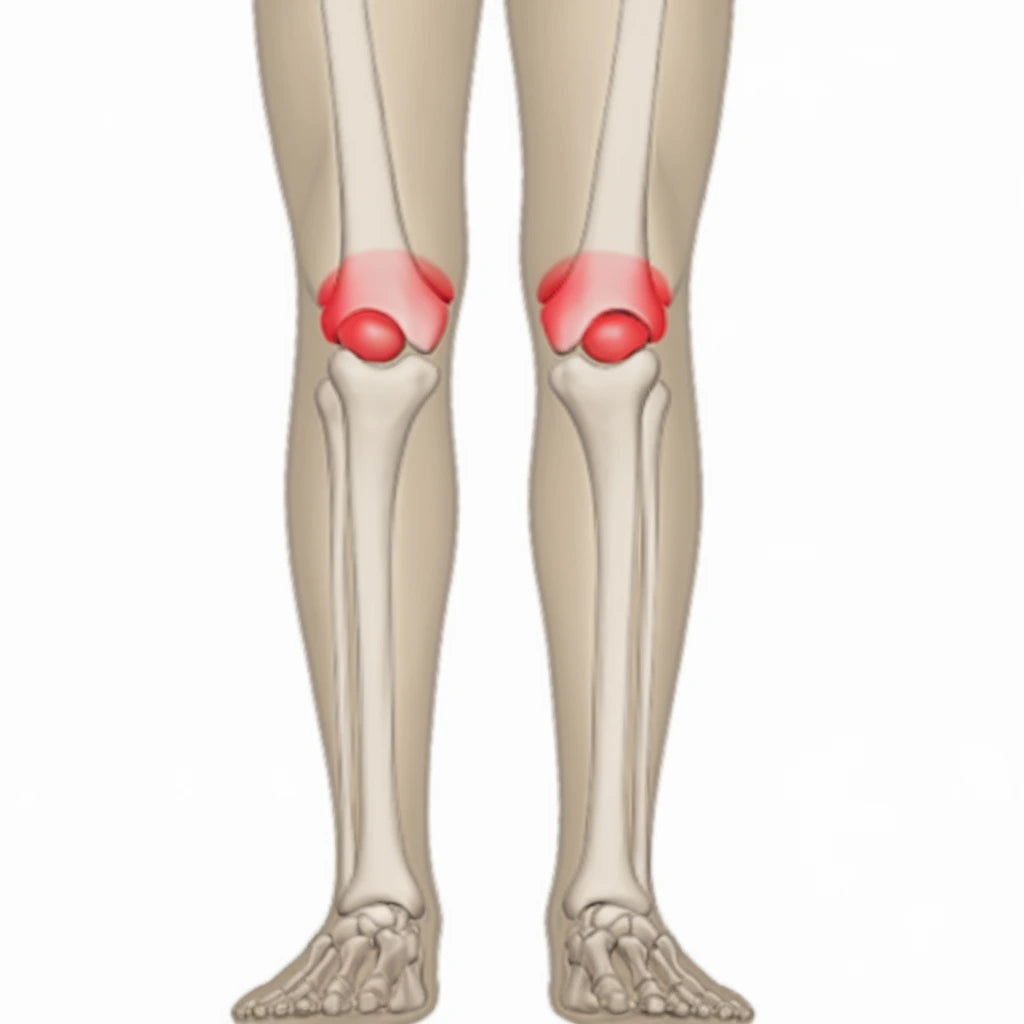Inflammation in the Knee: Causes, Symptoms, and Treatment

Knee inflammation is a common problem that can affect people of all ages. It can be caused by different factors and affect different parts of the knee, such as muscle attachments, bursae or the joint itself. In this article, we will go over the most common causes, symptoms and treatment options for knee inflammation. The knee joint is one of the largest joints in the body and when it is affected by inflammation, it can affect how the knee moves properly. Every step we take can hurt and the pain in the knee can be both acute pain and long-term. In order to restore function in the joint, it is important to get a diagnosis and the right symptoms and treatment.
What is knee inflammation and what causes it?
Knee inflammation can occur for several reasons. Overuse during sports often causes inflammation of the knee muscle attachment, while acute injuries and trauma can cause the knee to swell significantly. High load on the knee, especially when climbing stairs or bending, can in turn lead to tension and high pressure around the knee.
Osteoarthritis of the knee joint affects the articular cartilage and causes chronic inflammation with pain and disability. This condition can affect both knees at the same time. The bursa on the inside of the knee can also become inflamed after repeated strain.
Other common causes include meniscus injuries during rotation where the knee gives way, runner's knee on the outside of the knee, and cruciate ligament injuries after trauma. Impaired transport of fluid from the knee can also be the cause of swelling. In rare cases, infections can also cause severe inflammation of the knee.
Symptoms of knee inflammation – how does it feel when your knee is inflamed?
Inflammation in the knee joint can be caused by overuse, injury, osteoarthritis, or rheumatic conditions. Symptoms vary depending on the cause and degree of inflammation, but there are several typical signs to look out for.
Pain
Pain is the most common symptom of knee inflammation . It often occurs with strain or movement, for example when walking up stairs or bending the knee. The pain may decrease at rest, but in more pronounced inflammation it may also be present when standing still.
Swelling
Inflammation leads to fluid accumulating in or around the knee joint, causing swelling. This can be felt as a pressure or tight feeling in the knee, especially after activity. The swelling may be due to impaired fluid circulation in the joint.
Redness
The area around the inflamed knee may become red and warm to the touch. The redness is a sign of increased blood flow and the body's attempt to fight the inflammation.
Stiffness
Stiffness often occurs in the morning or after prolonged periods of inactivity. It makes it difficult to bend or extend the leg normally, and mobility usually improves only after “getting moving.”
Impaired mobility
In more extensive inflammation, it may be difficult to fully bend or extend the knee. This can lead to both pain and disability, v
Treatment of knee inflammation – how to relieve knee pain
- Resting and unloading the affected knee to reduce high stress on the knee
- Cold therapy to improve fluid transport from the knee and reduce inflammation
- Compression with elastic bandage or support stocking to reduce tension and high pressure
- Anti-inflammatory medications as needed to relieve pain and inflammation
- Physiotherapy where stretching exercises can contribute to better mobility and function in the joint
- Use of knee braces or orthoses for support when climbing stairs or during activity
- In more severe cases, injections of cortisone or other medication for knee inflammation may be needed.
- For osteoarthritis of the knee, specific treatment can be aimed at relieving pain and improving function.
Treatment of knee inflammation should always be tailored to the specific cause. Self-care may be sufficient in mild cases, but in more severe cases, it is important to get a diagnosis from a doctor or orthopedic surgeon.

Innovative aids for knee inflammation – Knee Comfort™ and ThemoReliever™
The Knee Comfort is a specially designed knee brace that offers several benefits in the treatment of knee inflammation:
- Provides compression that reduces swelling when the knee swells after activity
- Increases blood circulation to promote healing of inflammation in the knee muscle attachment
- Improves proprioception so that the knee moves properly during every step we take
- Can be used on both knees simultaneously if needed and effectively relieves pain
The Knee Comfort is designed to provide optimal support without restricting movement unnecessarily, making it suitable for daily use for knee problems such as inflammation, bursitis and osteoarthritis of the knee joint. Read more about bursitis in the knee .
For additional relief, especially during cold periods, TermoReliever can be a valuable addition. This product combines heat therapy with support to:
- Provide natural pain relief through heat that reduces acute pain
- Increase comfort in the winter cold for the body's largest joint
- Potentially improve transport of fluid from the knee
- Reduce the stiffness that often occurs when walking up stairs with knee inflammation
Conclusion – relieve knee pain with proper diagnosis, treatment and self-care
Knee inflammation can be painful and limiting, but with proper diagnosis and treatment, most people can return to their normal activities. By paying attention to early signs and implementing appropriate treatment methods, including the use of supportive aids such as Knee Comfort and ThermoReliever, knee inflammation can be effectively managed and prevented.
Self-care plays an important role in managing knee problems. Stretching exercises can help improve mobility and strengthen the muscles around the knee. However, it is important to understand that inflammation in the knee can vary in severity and cause. Therefore, treatment should be tailored to the specific situation to restore function to the joint.
For long-term inflammation or severe symptoms such as pain and disability, you should always consult a healthcare provider, as the correct diagnosis can in turn lead to more effective treatment.
Frequently Asked Questions (FAQ)
How long does a typical knee inflammation last?
A mild knee inflammation can heal within 1-2 weeks with proper treatment, while more severe cases can take several weeks or months. Using the Knee Comfort can potentially speed up the healing process by providing support and reducing strain on the inflamed muscle attachment.
Can I exercise with knee inflammation?
It depends on the severity of the inflammation. Light, low-intensity exercise that does not cause high stress on the knee can often be possible, especially with the support of Knee Comfort. Activities such as swimming or cycling on flat ground can be performed without causing pain. Always consult a doctor or physiotherapist before resuming exercise.
When should I seek medical attention for knee inflammation?
Seek medical attention if your knee pain is severe, if your knee is very swollen, if you have a fever, or if your symptoms do not improve after a few days of self-care and use of supportive products such as Knee Comfort and ThermoReliever. Other warning signs include an inability to bear weight on your leg or if your knee gives way in certain positions.

